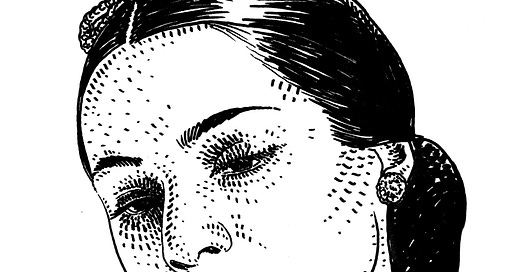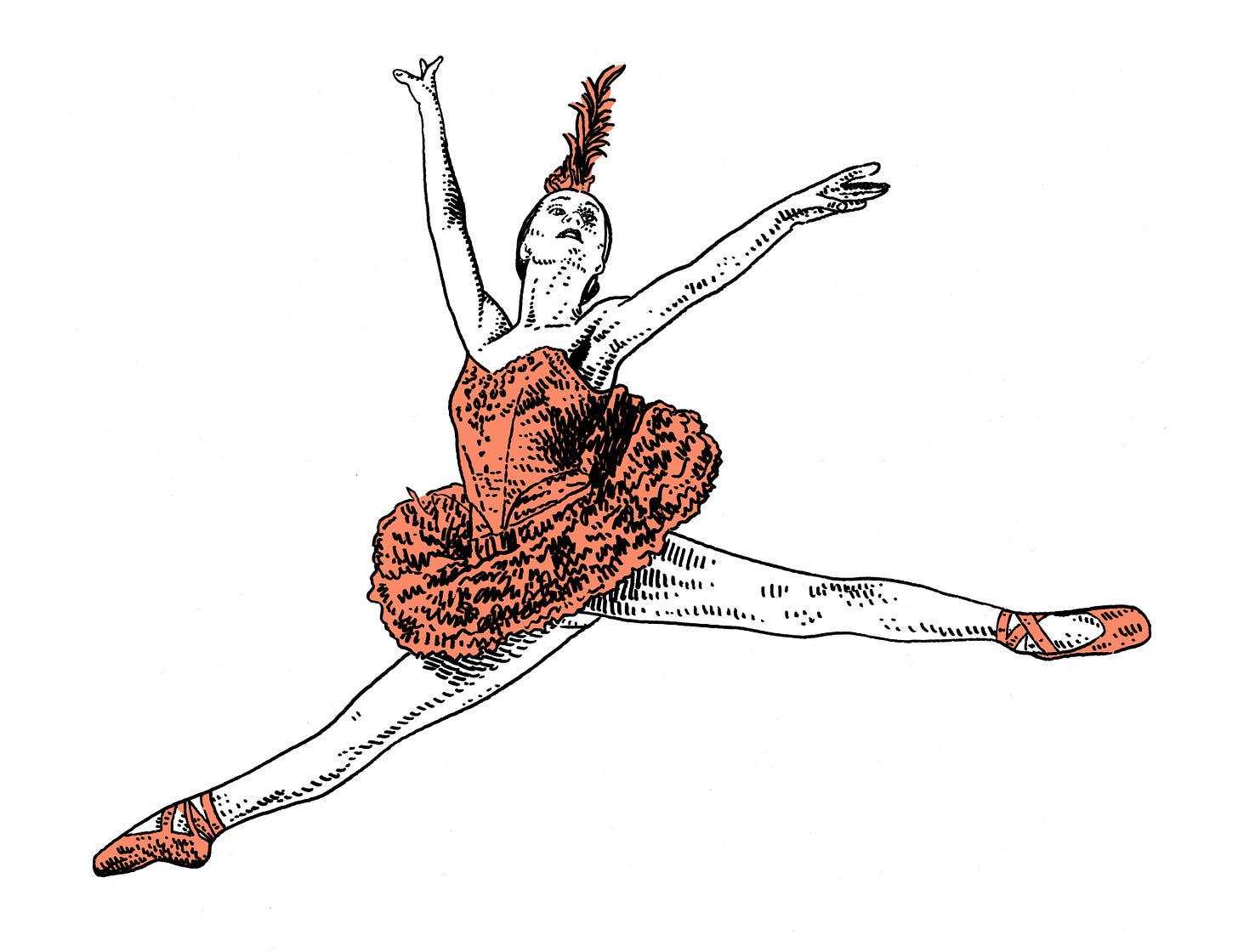The Firebird
On the legendary ballerina Maria Tallchief, and finding transcendence in art and sports.
Welcome to Sports Stories, a newsletter that explores sports and history at the intersection of everything. If you’re not already a subscriber, you can sign up here.
Until very recently -- like this week -- I was under the impression that one of the secrets to Michael Jordan’s success on the basketball court was that he took ballet classes in the offseason. I’m not sure where this notion came from exactly. I think when I was a kid, my mom told me that some NBA players did ballet in order to offer me a much needed reminder that strength and grace and athleticism can be found in places beyond the comprehension of my narrow SportsCenter-obsessed brain. Then in some deep inaccessible corner of that brain, her offhand remark grew into a true fact: Michael Jordan was a ballet dancer and that was why he was the best.
It turns out that there is no evidence of Michael Jordan taking ballet classes. (Though Kobe Bryant did study tap dancing to recover from a leg injury one offseason.) There was a time in my life when I watched sports caring a lot more about the final score than the actual journey to that result. As I get older, the way I appreciate sports has changed. What I’m really looking for now is that moment of transcendence: to be carried away by grace and power and artistry. The way I marvel at a Michael Jordan highlight on YouTube is really not that different from the way I might watch a video of the subject of this week’s newsletter, Maria Tallchief.
Maria Tallchief was born in 1925 in Fairfax, Oklahoma on the Osage Reservation at a time when massive oil fortunes were being made, and hundreds of Osage Nation members were being gunned down, poisoned, and bombed by predatory white outsiders trying to steal those fortunes. Her entire life would have the quality of encapsulating a country at both its worst and its best; of flirting with, and then upending preconceived notions about what America is.
That starts with her parents. Maria’s father Alexander was the direct descendent of an Osage Nation chief named Peter Big Heart. Alexander Tall Chief was a widower, rich in oil money, when he met Maria’s mother -- a white woman named Ruth Porter whose sister worked as a housekeeper for Alexander’s mother. As young children, Maria and her younger sister Marjorie were taken to ballet and piano classes. Ruth was convinced that her girls would be stars. When Maria was 8 years old, they moved to Los Angeles where dreams come true.
This is how Maria later wrote about the beginning of her career in Los Angeles:
Anyway, it turned out Ernest Belcher was a world class dance instructor. His students included Fred Astaire and Shirley Temple. Belcher’s daughter Margaret was the model for Disney’s Snow White and became a world famous dancer in her own right. Maria and Marjorie stayed with Belcher until they were teenagers, when they upgraded to an even higher class ballet studio run by a legendary Russian dancer named Bronislava Nijinska. By 15, Maria was a lead dancer in Nijinska’s productions at the Hollywood Bowl.
Maria graduated from Beverly Hills High School. She appeared in a single movie -- as an ensemble dancer behind Judy Garland -- before realizing that Hollywood was a vapid and soulless place. Ballet was her calling and would be her life. Soon she would be in New York, and soon she would meet a choreographer named George Balanchine. The two were made for one another: they fell in love, they elevated each other and they changed the whole conception of what ballet could be. It was like Tom Brady and Bill Belichick if Brady and Belichick had been briefly married.
I make that comparison (glib as it seems) intentionally. In ballet, just as in sports with coaches, there is a tendency to obsess over the genius of the choreographer. Balanchine had a vision of ballet that was faster and more physical than his predecessors. But as Balanchine’s prima ballerina, Maria Tallchief not only realized that vision -- she elevated it. You could see it in an instant. You could especially see it in Balanchine’s version of a Russian ballet called Firebird.
I have watched this clip a dozen times at least in the last week. It looks like she is dancing on the moon. It’s a clip that brings to mind the fact that despite how they might be presented in society, art and sports are not diametrically opposed forces. They exist on a spectrum. As spectators and participants, they both allow us to do things that take ourselves and others beyond the normal plane of consciousness. There are moments for me as a writer when time disappears and the world disappears and the words come forth from a place I can’t otherwise access. This happens with painters and with musicians and it happens with dancers and it happens with athletes. The greatest among us -- the Maria Tallchiefs -- can take us to that place even as spectators.
What so amazes me about ballet in particular is that -- though we can’t fully see it here -- it’s a cumulative, collaborative, act. First you have the partnership of the two dancers in the clip Then you have the choreography by Balanchine. Then the music, written by Igor Stravinsky telling a story steeped in generations of Russian folklore. All of it building together toward this incredibly beautiful, impossible thing.
Here’s another clip, from a Balanchine performance of Swan Lake:
Maria Tallchief needed to have physical genius, musical genius, an impossibly high pain tolerance, and a willingness to immerse herself completely in her craft. She had all of those things -- plus charisma and grace that followed her off the stage. She did not merely become America’s most famous ballerina. She elevated ballet as popular entertainment in the United States. It took a woman from the Osage Nation to turn this delicate and distant and distinctly European preoccupation into a truly American artform.
Here’s a mind-blowing sentence written by a dance historian named Rebekah Kowal:
If postwar American ballet can be seen as a metaphor for the coordination of cultural diversity to one unifying idea, then Tallchief's balletic prowess becomes symbolic not only of her personal transformation into the most celebrated mid-century American ballerina, but also of an assimilation process by which, within a dominant cultural formula, the U.S. had moved from being a nation composed of a myriad of ethnic “others” to a consolidated identity to which these others became subordinated.
Tallchief was on the cover of Newsweek. She made more money than Mickey Mantle (another Oklahoman transplanted to New York). She starred in Swan Lake and became the first prima ballerina of what would become the New York City Ballet. Along with Balanchine, she cemented The Nutcracker as an enduring American holiday tradition.
She did it, of course, at a time when the United States was obsessed with cowboy movies that showed Native characters as ruthless hollering murderers; when the discrimination was active and omnipresent. At the time, it was common for American ballerinas to change their names to sound more Russian. She could go by Tallchieva, as one magnate suggested. But she refused. “Never!” she said, opting instead to simply combine Tall Chief from two words into one. Even when Tallchief was being celebrated, the subtext was right there all along -- sometimes it wasn’t even subtext. “Onstage, she looks as regal and exotic as a Russian princess; offstage, she is as American as wampum and apple pie,” wrote Newsweek.
As I was writing this week’s newsletter, I kept jotting down notes about the spectrum between art and sports. What’s what? What’s the difference? At what point do all the artificial rules that we use to categorize various human activities break down? It’s all interconnected anyway. It’s all part of how we make the best of being alive as individuals and as a collective.
Michael Jordan didn’t do ballet. But one of my best friends growing up -- and to this day -- was a star offensive lineman for our high school football team. He was massive at the time: 6’2” at least 350 pounds. He was getting recruiting letters from programs all over the west coast: Oregon, Washington, USC. There was a lot to like about his game: he was strong, cerebral, and ruthlessly competitive -- but above all, he was nimble. His footwork was immaculate. Why? Because he spent hours at the arcade playing Dance Dance Revolution.
Anyway, Michael Jordan didn’t do ballet. But maybe Maria Tallchief played basketball. She retired in 1965 and eventually settled in Chicago where she founded a ballet company and spent decades teaching. She passed away in 2013 at the age of 88.
Introducing the Sports Stories Store!
Just as ballet achieves its transcendence through the cumulative, collaborative power of dance, choreography, music, and story -- Sports Stories achieves whatever it is we have through the collaboration of Adam’s art and my writing. But that’s not enough for this project to really work. What really makes it work is you -- the readers. We’re so appreciative of the community that has sprung up around this newsletter. In case it wasn’t obvious, Sports Stories is a DIY endeavor. So we’ve created a web shop with a few simple items that express the vibe and that we’d love for you to check it out. The pictures below are clickable:
The runs on everything we sell here are limited. This isn’t one of those on demand screen printing deals. The hats and shirts physically exist in the world. So if you like something, please go ahead and pick it up before it’s gone!
Related Reading
Earlier in the newsletter, I mentioned Maria Tallchief’s younger sister Marjorie. Incredibly, she also became a superstar ballerina. But while Maria made her fame in the United States, Marjorie made hers in Europe.
There’s a ton out there on Maria and her career. If you’re really curious, I’d start with her memoir, which is very readable. I also thought the Washington Post obituary was compelling and complete and enjoyed this NPR story which features an interview with Maria’s daughter, the poet Ellen Paschen.
For a more academic and critical look at race, ballet, and Tallchief’s legacy, the article I quoted above by Rebekah Kowel is available online in its entirety thanks to the fine folks at Dance Research Journal.
It’s also hard to really consider Maria Tallchief without fully giving consideration to her relationship with Balanchine. Tallchief later wrote that their marriage was somewhat soulless. They slept in separate beds and he saved all his passion for the work. But their artistic collaboration continued in the years after their divorce, and Tallchief remained a loyal student and advocate of Balanchine’s even after his death. You can read more about Balanchine, and their collaborative work, through the Balanchine Foundation.
Important Lola Falana Wiki Update
Yesterday, our pals at the website Defector republished our story from last month on the question of whether Lola Falana won a piece of the Mets in a baccarat game in 1980s Atlantic City. (We’re going to be making the Defector partnership a regular thing.) But a funny thing happened on the way to publishing: while we were preparing the story for them, we realized that Lola Falana’s wikipedia page -- which for years contained the unproven story of her Mets ownership -- has finally been updated.
The Mets anecdote is gone. And in the page’s edits, you can see the following:
Sports Stories has officially made history.
Thank you for reading. Please be sure to check out the store. See you next week.









